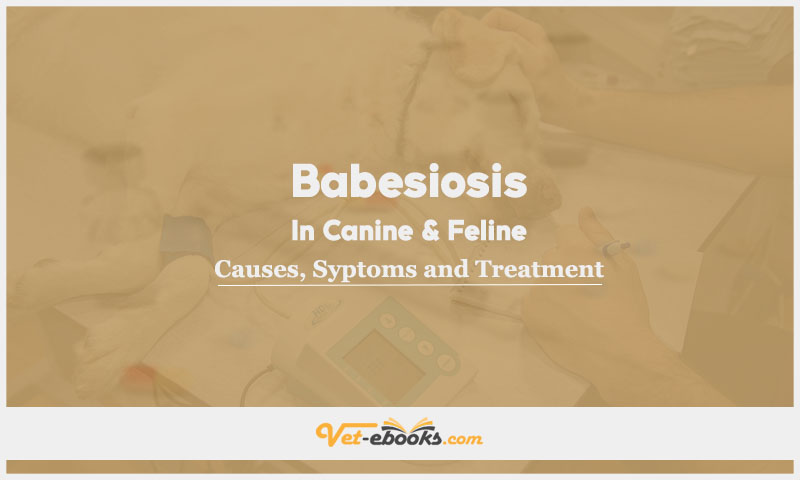Babesiosis In Canine and Feline: Causes, Symptoms and Treatment

Contents
hide
Overview
A protozoal disease caused by the Babesia genus that affects dogs and cats by infecting red blood cells with merozoites (known as piroplasms).
The extent of the illness typically correlates with the severity and the development of the anemia.
Anemia primarily results from immune-mediated hemolysis, although direct damage to red blood cells by piroplasms also contributes to it.
Causes of Babesiosis In Canine and Feline
Causes
- This condition is caused by protozoal parasites belonging to the Babesia genus, which invade the red blood cells (RBCs) of mammals.
- Among the larger Babesia species that infect dogs: Babesia vogeli is transmitted by Rhipicephalus sanguineus, Babesia canis is transmitted by Dermacentor reticulatus and is primarily located in Europe, Babesia rossi is transmitted by Haemaphysalis leachi and is predominantly found in Africa, Babesia sp. (Coco) is associated with an unknown tick vector and has been mainly identified in splenectomized and immunosuppressed dogs in the United States.
- Smaller Babesia species (measuring 2-5 μm) that infect dogs include: B. gibsoni, which has a global distribution, B. conradae, Babesia vulpes
- There have been several case reports of new Babesia species and other piroplasms, like T. equi, infecting dogs.
- Smaller piroplasms (2-5 μm) that affect cats include: B. felis, which has been reported in Africa, Cytauxzoon felis, which is found in the United States.
Risk factors
- A previous incident of ticks attaching to the animal’s body.
- Animals that have Splenectomy tend to experience more severe clinical symptoms.
- Having a history of undergoing chemotherapy increases the risk of contracting Babesia sp. (Coco) infection.
- Immune suppression can result in clinical signs and heightened parasitic presence in dogs already dealing with chronic infections.
- A recent history of a dog-bite wound is a risk factor for B. gibsoni (Asia) infection.
- Receiving a recent blood transfusion from a donor who is subclinically infected can also pose a risk.
Pathogenesis of Babesiosis In Canine and Feline
- Infection can occur through tick transmission, direct transfer via blood during dog bites, blood transfusions, or transplacentally.
- The incubation period typically lasts around 2 weeks, although some cases may not be clinically diagnosed for months to years.
- Piroplasms infiltrate and reproduce within red blood cells (RBCs), leading to both direct and immune-mediated hemolytic anemia.
- Immune-mediated hemolytic anemia is more clinically significant than anemia caused directly by the parasites, as the severity of symptoms is not determined by the degree of parasitemia.
- This condition primarily affects the hematological, lymphatic, and immune systems, leading to anemia.
Symptoms (History & Physical Examination) of Babesiosis In Canine and Feline
- The infection can take various forms, including peracute, acute, chronic, or even remain asymptomatic in some carrier animals.
- Spleen removal and immunosuppression can significantly exacerbate the disease, particularly in cases of B. canis rossi in Africa, or make it more evident, as seen with B. canis infections in the United States.
- Immunosuppression can lead to increased parasitemia and the emergence of clinical signs in dogs with chronic B. canis infections.
- Common signs of the disease include: Lethargy, Loss of appetite, Weight loss, Pale mucous membranes, Fever, Enlarged spleen (splenomegaly), Swollen lymph nodes (lymphadenopathy)
- Dogs with this infection may also exhibit: Hemoglobinemia/uria, Jaundice.
- Gastrointestinal symptoms such as vomiting, diarrhea, and dark feces (resulting from increased bilirubin excretion).
- In cases of cerebral babesiosis (B. canis rossi in Africa), dogs may experience weakness, disorientation, and even collapse.
- Renal and urologic complications in B. canis rossi infections in Africa can lead to renal failure.
- In cats, symptoms may include lethargy, loss of appetite, pale mucous membranes, and jaundice.
Diagnosis of Babesiosis In Canine and Feline
1- From History and Physical Examination
2- Diagnostic Procedures
CBC/BIOCHEMISTRY/URINALYSIS
- Anemia can range from absent to severe, typically regenerative (evidenced by reticulocytosis) unless symptoms are extremely acute, with severely affected cases having a packed cell volume (PCV) of less than 10%.
- Thrombocytopenia is usually moderate to severe, and some animals may experience thrombocytopenia without concurrent anemia.
- Both leukocytosis (increased white blood cell count) and leukopenia (reduced white blood cell count) have been reported.
- Hyperbilirubinemia varies depending on the rate of hemolysis.
- In chronic infections, hyperglobulinemia is common and may be the sole biochemical abnormality in certain cases.
- Mildly elevated liver enzyme levels can result from anemia or hypoxia.
- Proteinuria and hypoalbuminemia (indicative of protein-losing nephropathy) may occur.
- Infections with B. canis rossi, B. gibsoni, and B. vulpes have been associated with azotemia and metabolic acidosis due to renal failure.
- Bilirubinuria is frequently observed.
- Hemoglobinuria is less commonly detected in the United States compared to Africa.
OTHER LABORATORY TESTS
- Examination of stained thin or thick blood smears under a microscope can provide a definitive diagnosis, although it may not distinguish between species. The sensitivity of this method depends on the microscopist’s experience and staining technique, with better results achieved using a modified Wright stain. The use of capillary blood may enhance sensitivity.
- Indirect fluorescent antibody (IFA) testing involves analyzing serum antibodies. However, cross-reactive antibodies can hinder the differentiation of species and subspecies. Additionally, some infected animals, especially young dogs, may not show detectable antibodies.
- PCR (polymerase chain reaction) can identify the presence of Babesia DNA in a biological sample, typically ethylenediaminetetra-acetic acid (EDTA) anticoagulated whole blood. This method can differentiate between subspecies and species.
3- Differential Diagnosis
- Various conditions can lead to immune-mediated hemolytic anemia or thrombocytopenia, including but not limited to idiopathic immune-mediated hemolytic anemia or thrombocytopenia, ehrlichiosis, Rocky Mountain spotted fever, systemic lupus erythematosus, neoplasia, endocarditis, hemotropic mycoplasmosis (haemobartonellosis), and cytauxzoonosis.
- It’s important to note that a positive Coombs’ test does not exclude the possibility of babesiosis because many animals with babesiosis also test positive in Coombs’ tests.
- Non-immune-mediated hemolytic anemia, such as microangiopathic anemia, caval syndrome, splenic torsion, disseminated intravascular coagulation (DIC), Heinz body anemia, pyruvate kinase deficiency, and phosphofructokinase deficiency, can also cause these conditions.
- Conditions leading to hepatic and posthepatic jaundice should also be considered.
Treatment of Babesiosis In Canine and Feline
General
- The choice between inpatient or outpatient care depends on the severity of the disease.
- Patients with anemia may require a transfusion of whole blood or packed red blood cells (in cases of RBC mass loss).
- In situations where fresh blood is not readily available, polymerized bovine hemoglobin solution may be considered as an alternative, although it is not superior to packed red blood cells.
- For severely affected individuals, aggressive fluid therapy is necessary to address hypovolemic shock resulting from blood loss, often associated with bleeding due to thrombocytopenia.
Medications:
- Imidocarb Dipropionate is the preferred treatment. May completely eliminate B. canis infections and reduce both morbidity and mortality.
- Imidocarb dipropionate (FDA approved; administered at 6.6 mg/kg subcutaneously or intramuscularly every 1–2 weeks) and diminazine aceturate (not FDA approved; given at a dose of 3.5–7 mg/kg subcutaneously or intramuscularly every 1–2 weeks) can reduce morbidity and mortality in affected animals. These treatments may entirely clear B. canis and B. vogeli infections but are less effective against B. gibsoni.
- Diminazine aceturate Demonstrates similar efficacy to imidocarb dipropionate.
- Metronidazole, clindamycin, and doxycycline can alleviate clinical symptoms and reduce parasite numbers below the limit of detection for PCR testing, but they may not necessarily clear the infection.
- Azithromycin used in conjunction with atovaquone. Proven effective in treating Babesia infections in humans and mice.
- Combination therapy involving azithromycin (at a dose of 10 mg/kg orally once daily for 10 days) and atovaquone (at a dose of 13.5 mg/kg orally every 8 hours for 10 days) stands as the preferred treatment and is the only option potentially capable of completely clearing B. gibsoni (Asia) infections in dogs. In a controlled study, 85% of dogs successfully cleared the infection following this treatment.
- A combination of clindamycin (at a dose of 25 mg/kg orally every 12 hours), metronidazole (at a dose of 15 mg/kg orally every 12 hours), and doxycycline (at a dose of 5 mg/kg orally every 12 hours) has been linked to the elimination or reduction of the parasite to levels undetectable by PCR testing in dogs. However, a definitive treatment duration has not been established, with therapy ranging from 24 to 92 days. A minimum treatment duration of 90 days is recommended.
- Another combination therapy involving doxycycline (at a dose of 7–10 mg/kg orally once daily), enrofloxacin (at a dose of 2–2.5 mg/kg orally every 12 hours), and metronidazole (at a dose of 5–15 mg/kg orally every 12 hours) administered for 6 weeks led to clinical remission in 85% of dogs. However, no PCR testing was conducted to assess its impact on parasitemia.
- Metronidazole (at a dose of 25–50 mg/kg orally once daily for 7 days), clindamycin (at a dose of 12.5–25 mg/kg orally every 12 hours for 7–10 days), or doxycycline (at a dose of 10 mg/kg orally every 12 hours for 7–10 days) can alleviate clinical signs but are typically insufficient to clear infections.
- Primaquine phosphate is the preferred treatment for cats with B. felis.
- Prednisone treats the immune-mediated component of anemia.
- immunosuppressive agents like prednisone (at a dose of 2.2 mg/kg/day orally) may be considered in cases where antiprotozoal treatments alone are ineffective. Prolonged immunosuppressive therapy prior to specific antiprotozoal therapy is not recommended.
Veterinary Books Suggestions
Some Notes:
- It’s important to note that antibabesial drugs (imidocarb and diminazene) may lead to cholinergic signs, which can be minimized by administering atropine (at a dose of 0.02 mg/kg subcutaneously 30 minutes prior to drug administration).
- Perform follow-up CBC and biochemistry tests as necessary to monitor the resolution of anemia, thrombocytopenia, icterus, and other conditions.
- In most cases, patients exhibit a clinical response within 1–2 weeks of treatment.
- Conduct 2–3 consecutive negative PCR tests, starting 2 months after treatment initiation, to rule out treatment failure and persistent parasitemia. It’s advisable not to rely on IFA titers for follow-up since these titers can persist for extended periods.
- In situations where a dog in a multi-dog kennel is diagnosed with babesiosis, it’s recommended to screen all dogs within that kennel, as there is a high likelihood of carrier animals in such environments.
- Consider the possibility of coinfection with other vector-transmitted pathogens (e.g., Ehrlichia, hemotropic Mycoplasma, Leishmania), especially in cases where animals do not respond to treatment.
- Recent research suggests that the use of acaricides can help reduce the transmission of Babesia spp. It’s important to promptly remove all attached ticks.
- Vaccines for B. canis and B. rossi are available in Europe but may not provide protection against other Babesia spp. Therefore, tick control remains crucial for disease prevention.
- All potential blood donors should test negative for Babesia spp.
Tip
Do You Want To Increase Your Veterinary Knowledge and Practical Skills?
You Can Now Browse and Download +3000 Books For Veterinary Professionals & Students Online.
Download Veterinary Books
















